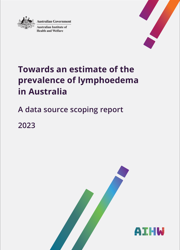Summary
Lymphoedema is a condition where the accumulation of excessive amounts of protein-rich fluid in the tissue results in swelling of one or more regions of the body (ALA 2021). Lymphoedema occurs when the demand for lymphatic drainage exceeds the capacity of the lymphatic system and may develop due to a congenital malformation in the lymphatic system (primary lymphoedema), or due to damage to the lymphatic vessels or nodes (secondary lymphoedema).
Lymphoedema is a chronic condition requiring lifelong care. Treatment and management of lymphoedema requires care from a multidisciplinary team and the use of compression garments, which can be expensive. To help with this expense, Australian states and territories each have individual subsidy schemes for compression garments to assist those living with the condition.
There is currently no population-level prevalence estimate for the number of people in Australia living with lymphoedema. The purpose of this scoping study is to assess the utility of available data sources in determining an estimate of the number of Australian’s living with lymphoedema.
What can the available data sources tell us about lymphoedema?
- In 2020–21, the age-standardised rate of hospitalisations for lymphoedema as the principal or additional diagnosis was 30 per 100,000 population (9,400 hospitalisations), with the rate higher for females (6,500; 40 per 100,000 population) than for males (2,900; 20 per 100,000 population).
- Some types of lymphoedema are related to cancer treatment and based on projected new cancer cases for 2022, around 4,100 people with breast cancer and between 1,600 and 5,100 people with melanoma of the skin will go on to develop secondary lymphoedema.
- Based on reporting covering 2020, around 2,500 people accessed state and territory compression garment subsidy schemes (excluding Queensland and Tasmania) with around 9,300 garments issued (excluding New South Wales and Tasmania). Note, more work is needed to understand the prevalence in the Indigenous population.
No single data source is able to provide a holistic estimate of prevalence
The data sets with the most utility for calculating the prevalence of lymphoedema in Australia are the Australian Cancer Database, MedicineInsight and the National Integrated Health Services Information Analysis Asset (NIHSI-AA; includes admitted patient care, emergency department care, residential aged care, Medicare Benefits Schedule, Pharmaceutical Benefits Schedule and the national mortality register). A national primary care data set would encompass data from general practice as well as allied health professionals (such as physiotherapists) and would enhance the ability to identify people with lymphoedema in the community. Data linkage with NIHSI would enable the development of a representative estimate of the number of people in Australia living with lymphoedema. A National Primary Care Data Asset is in the early stages of development but will not be available for some time.
Compression garment subsidy scheme data could provide prevalence estimates
In July 2020, the then Minister for Health announced that Australians diagnosed with lymphoedema would have greater access to compression garments, thanks to ongoing funding from the Australian Government to complement the subsidisation of compression garments for people with lymphoedema under existing state and territory schemes. The introduction of these additional funds and the associated reporting to the Australian Government Department of Health and Aged Care provides an opportunity to collect information on the number of people in Australia living with lymphoedema. However, differences in how the states and territories administer the compression garment subsidy are likely to have had an impact on the data collected so far (discussed in Further investigation of compression garment data sources section).
Issues with the identification, diagnosis and treatment of lymphoedema
A critical issue is the misdiagnosis, or missing diagnosis of the condition due to lack of understanding and awareness of its presentation among medical practitioners. This leads to an under-diagnosis of the condition. Appropriate training and the provision of resources will help to facilitate early detection of the condition and improve outcomes for people living with lymphoedema.
It is important to note that when attempting to identify people living with lymphoedema in available data sets there will be limitations relating to the definitions and terminology used. For example, most available data relate to lymphoedema as a result of cancer treatment and therefore underestimate the total prevalence of lymphoedema in Australia which needs to include primary lymphoedema and non-cancer-related lymphoedema.
Summary
1. Introduction
1.1 Purpose of this report
1.2 Structure of this report
2. Lymphoedema
2.1 Primary lymphoedema
2.2 Secondary lymphoedema
2.3 Prevalence
2.4 Diagnosis
2.5 Treatment and management
3. Data sources: assessment approach
3.1 Types of data sources
3.2 AIHW framework for assessing data sources
3.3 Scope
4. Assessment of available data sources
4.1 Administrative data sources
4.2 Linked data sources
4.3 Survey-based data sources
4.4 Longitudinal surveys
4.5 Registry-based data sources
4.6 General practice Clinic Information System (CIS) data extraction data
4.7 Other data sources
5. Discussion
5.1 Data deficiencies and gaps
5.2 Future opportunities and next steps
End matter: Acknowledgements; Abbreviations; Glossary; References; List of tables



